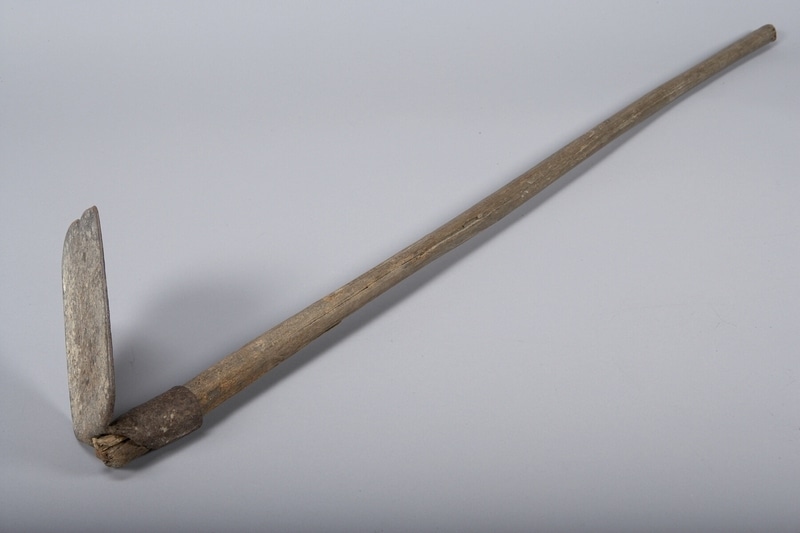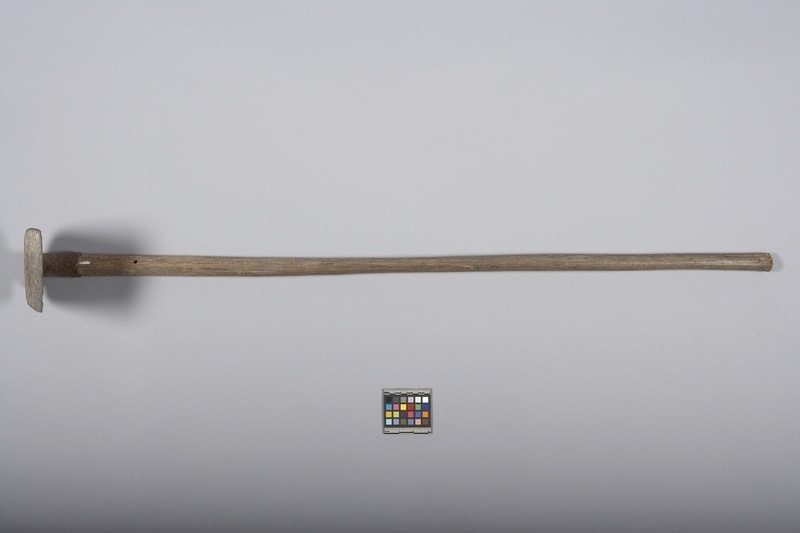Hoe Item Number: Edz1198 from the MOA: University of British Columbia


Description
Iron hoe set at a forty-five degree angle; attached to a long, straight wooden handle.
History Of Use
Such hoes were in common use, being employed primarily by women but occasionally by men. Until the 1960s Hakka women had primary responsibility for subsistence farming, as the men often worked elsewhere, or at occupations such as fishing. In the remote areas of Saikung, younger men often emigrated to urban areas of Hong Kong or overseas, to England or elsewhere, to try to make a living. In such cases any women left behind had to continue subsistence agriculture as well as depending on hoped-for remittances. Hoes such as these were used to loosen the soil by being pulled towards the person using it. After the mid-twentieth century the New Territories of Hong Kong began to undergo fundamental changes. The people who had been settled there before 1898, when the British colonizers claimed the area, began to give up rice agriculture and coastal fishing, turning instead to wage labour and increased employment overseas. By the end of the century, educational opportunities leading to the possibility of white-collar work also increased, together with western influences. These changes meant that objects and clothing once useful and appropriate were no longer needed and generally were discarded. Some were saved by their owners, who sometimes were willing to donate them to museums, sharing, also, their knowledge of how they were made and used.
Narrative
Mrs. Lau donated this and other farm implements to the Museum of Anthropology because she was elderly and had to give up rice agriculture after a fire had burned her stored crop. In 1980, the remote villages of Sai Kung Districted were inhabited primarily by elderly people who were unable or unwilling to emigrate with their family members. Hakka people are one of the two original land-dwelling groups that settled the area that became the New Territories of Hong Kong. Their spoken language, and some customs, differed from those of the other original group, the Cantonese or Punti. The Cantonese arrived first and settled on the best rice-growing lands, while the Hakka began to arrive after the late 17th century and settled the more hilly lands.
Specific Techniques
The iron part was forged by a specialist, while the handle was hand-carved.
Cultural Context
daily use
Item History
- Made in Sai Kung, Hong Kong, China during 1950
- Collected by Elizabeth L. Johnson during 1979
- Owned by Elizabeth L. Johnson before March 17, 1980
- Received from Elizabeth L. Johnson (Seller) and Museum of Anthropology Shop Volunteers (Funding source) on March 17, 1980
What
Who
- Culture
- Chinese: Hakka
- Field Collector
- Elizabeth L. Johnson
- Previous Owner
- Elizabeth L. Johnson
- Received from
- Elizabeth L. Johnson (Seller) and Museum of Anthropology Shop Volunteers (Funding source)
Where
- Holding Institution
- MOA: University of British Columbia
- Made in
- Sai Kung, Hong Kong, China
When
- Creation Date
- during 1950
- Collection Date
- during 1979
- Ownership Date
- before March 17, 1980
- Acquisition Date
- on March 17, 1980
Other
- Condition
- poor
- Accession Number
- 0610/0168